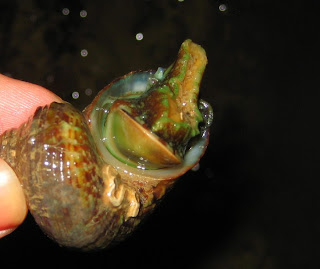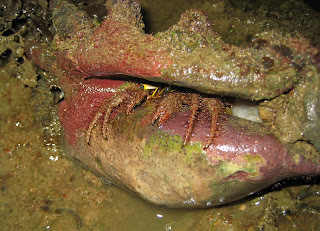
Ths snail coming out wondering whats going on outside?
 During low tides, we can see animals like the marine spider (Desis martensii) among the seaweed as well. It hides in air pockets among the rocks during high tide, coming out to feed on small invertebrates when the tide recedes. Its fangs inject poison to paralyse its prey.
During low tides, we can see animals like the marine spider (Desis martensii) among the seaweed as well. It hides in air pockets among the rocks during high tide, coming out to feed on small invertebrates when the tide recedes. Its fangs inject poison to paralyse its prey. Bigfin reef squids (Sepioteuthis sp., probably S. lessoniana) from the family Loliginidae.
Bigfin reef squids (Sepioteuthis sp., probably S. lessoniana) from the family Loliginidae.Squids are the fastest aquatic invertebrates, reaching up to 40km/h for some! They hunt for snails, clams, crabs and prawns. Squids communicates by changing of colours during their courtship. They camouflage really well from their preys and predators as well.
Can see nemo clownfish at the carpet anemone?(: this fish secretes mucus that disable the anemne from stinging them. is also believed that the movements of the fish inform the anemone of its identity. In return for the anemone's protection, the fish brings scraps to it, and lures larger fish into the anemone's tentacles.
Reef Hermit Crab (Dardanus lagopodes)
They are scavengers, with a good sense of smell. Unlike typical crabs, their back part of body is soft hence they use discarded shell for protection. & as they grow, they change to a bigger shell. //edited thanks ron for pointing out!

 Beautiful moon snail
Beautiful moon snailThese land hermit crabs are so well adapted to land that it will drown if kept underwater! So don't pick seashells from the seashore cause you are depriving them from a home!
 Black long sea cucumber (Holothuria leucospilota)
Black long sea cucumber (Holothuria leucospilota)These creatures can grow up to 1m long. When disturbed, it ejects sticky white threads to entangle the kajiao-er. It gathers edible bits frm the surface using its long feeding tentacles with bushy sticky tips.







No comments:
Post a Comment